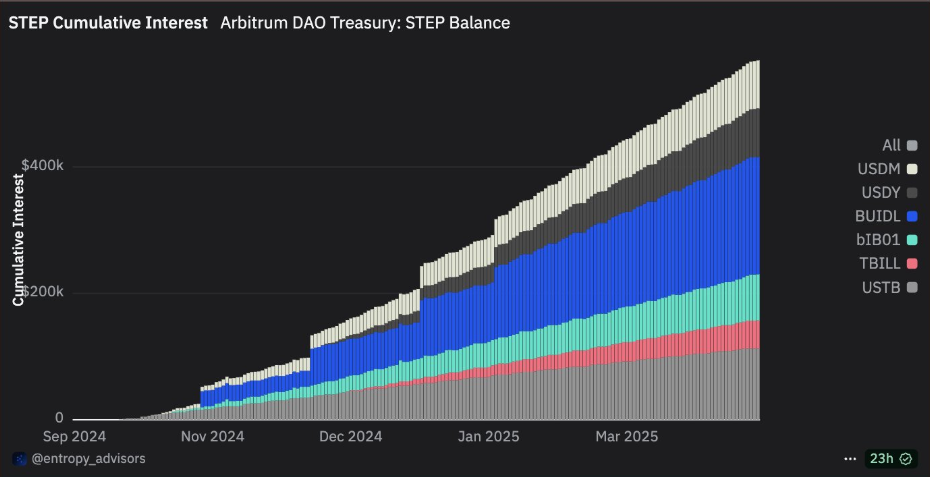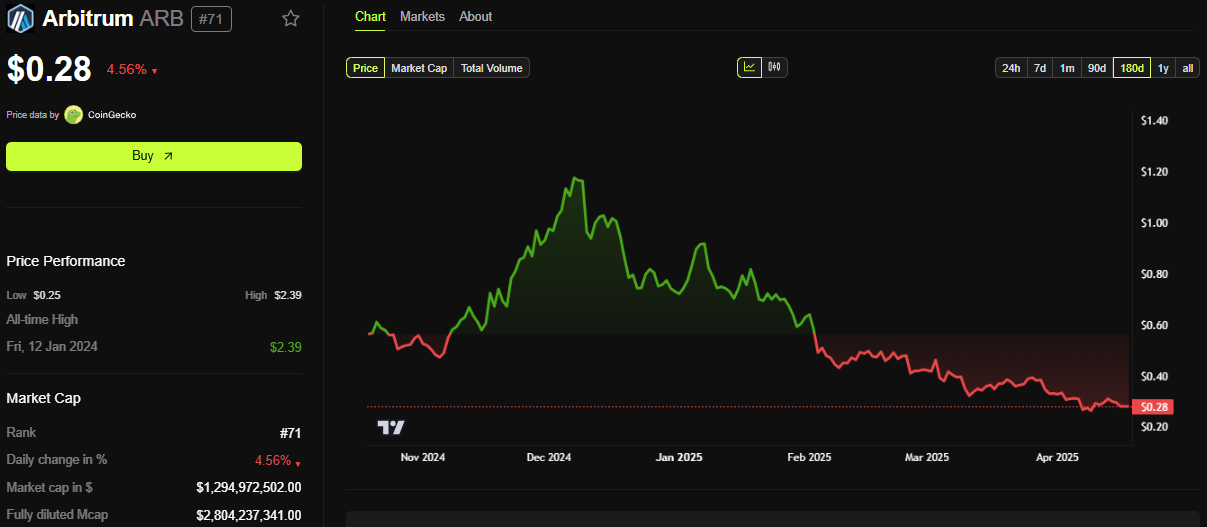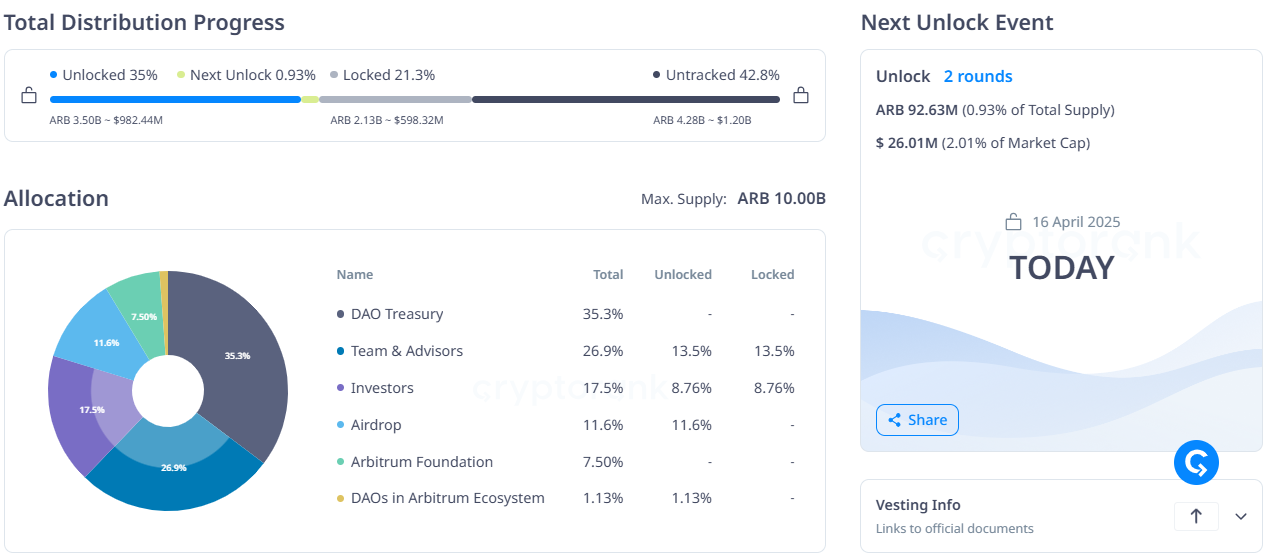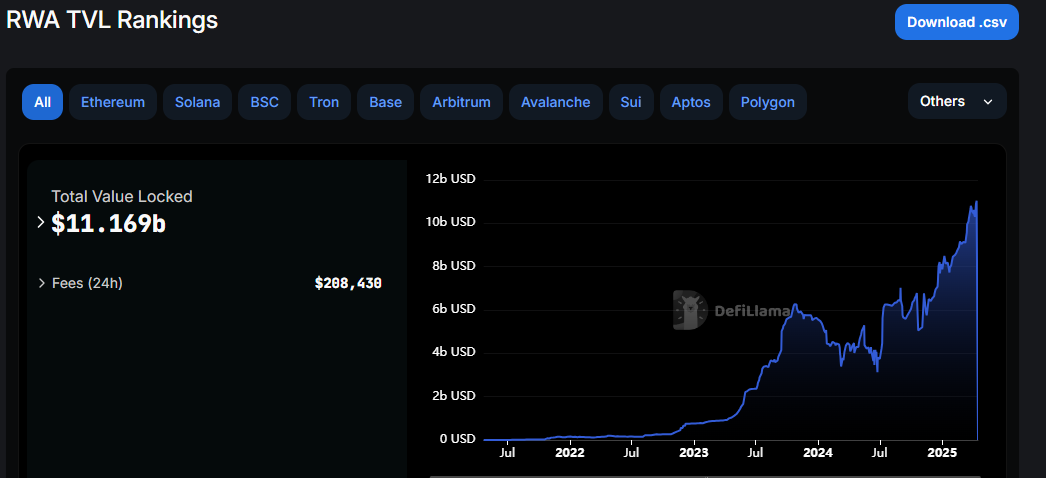Arbitrum’s RWA Market Surpasses $200 Million Amid Institutional Interest but Faces ARB Token Unlock Concerns
ARB
ARB/USDT
$128,072,138.77
$0.2240 / $0.2102
Change: $0.0138 (6.57%)
+0.0039%
Longs pay
Contents
-
Arbitrum recently made headlines as its real-world asset (RWA) market skyrocketed over 1,000%, now holding more than $200 million in tokenized assets.
-
This remarkable growth is largely driven by the Arbitrum DAO’s Stable Treasury Endowment Program (STEP) and increasing institutional adoption.
-
However, despite this impressive momentum, the ARB token has experienced a drastic decline of 88% from its all-time high, raising concerns of dilution stemming from an upcoming 92.63 million token unlock.
Discover how Arbitrum’s RWA market has surged alongside concerns over ARB token dilution, providing crucial insights into decentralized finance’s latest trends.
Arbitrum’s RWA Market Surges: A 1,000-Fold Increase
The value of real-world assets (RWAs) on the Arbitrum network has witnessed an unprecedented rise, increasing from a modest $100,000 at the start of 2024 to over $200 million today. This dramatic journey reflects one of the most explosive growth patterns observed in the decentralized finance (DeFi) space this year.
This exponential growth can be traced back to the initiatives outlined in the Arbitrum DAO’s Stable Treasury Endowment Program (STEP), which is currently in its phase 2 iteration. As part of this program, a total of 85 million ARB tokens have been allocated to harness stable, liquid, yield-generating RWAs.
“The DAO just approved 35M ARB for RWAs via STEP 2.0. This brings the total RWA investments from the DAO treasury to 85M ARB, one of the largest DAO-led RWA allocations in Web3,” Arbitrum stated in February.
This strategic approach aims to bolster the DAO’s resilience against the volatility commonly associated with native crypto assets, and early results indicate that this initiative is bearing fruit.

Dominating Arbitrum’s RWA landscape, US Treasuries account for approximately 97% of the sector, with Franklin Templeton’s BENJI leading, capturing a substantial 36% market share, followed by SPIKO’s European Treasuries at 18%. This diversification indicates a healthy progression towards enhanced global institutional interest.
“The ecosystem welcomes global diversification beyond US instruments,” remarked The Learning Pill, emphasizing the shift towards a more inclusive financial framework.
Additionally, new players like Dinari have emerged, enhancing the momentum by providing tokenized versions of various traditional securities, including stocks and ETFs (exchange-traded funds) through their dShares platform.
With over 18 tokenized RWA products in circulation on Arbitrum, spanning a range of asset classes from bonds to real estate, the network continues to underscore the institutional engagement. Arbitrum highlighted this significant trend via X (Twitter), stating, “RWA and Stablecoin adoption on Arbitrum has been monumental! Some of the largest institutions are bringing their tokenized assets to the land of liquidity with $4.7 billion in Stablecoins and over $214 million in RWAs already onchain.”
Industry players like Securitize, DigiFT, and SPIKO are engaged in tokenizing everything from sovereign debt to real estate portfolios, marking the early establishment of a novel financial infrastructure.
Despite the robust growth of the ecosystem, ARB, the native token of the Arbitrum network, has fallen sharply, down 88% from its all-time peak. This decline is compounded by looming dilution concerns from an imminent 92.63 million ARB token unlock.

Currently, only 46% of the total ARB supply is in circulation, which elevates apprehensions among investors regarding possible dilution and the absence of direct benefits from RWA expansion.

Tokenized Real-World Assets Exceed $11 Billion Market Cap
Beyond Arbitrum, the broader real-world asset sector is emerging as a cornerstone trend within the cryptocurrency landscape. Recent data from DeFiLlama indicates that the total value locked (TVL) in on-chain RWAs has surpassed an astonishing $11.169 billion, reflecting a staggering 2.5X increase over the previous year.

Tokenized US Treasuries and gold are the primary catalysts driving this surge, with BlackRock’s BUIDL fund now managing over $2.38 billion in tokenized Treasuries alone. Moreover, the demand for blockchain-based gold assets has intensified, pushing their market cap beyond $1.2 billion as noted in a recent COINOTAG report.
Ethereum continues to play a dominant role, hosting approximately 80% of all on-chain RWAs. As traditional finance (TradFi) entities search for programmable exposure to stable dollar yields and tangible assets, Ethereum offers the requisite infrastructure and liquidity necessary to bridge the gap between conventional capital markets and blockchain technology.
“The top RWA protocols aren’t chasing crypto narratives. They are providing reliable offerings that TradFi understands: yield, dollar exposure, and gold. This isn’t just the future of DeFi; it’s the evolution of finance,” remarked DeFi analyst Patrick Scott.
Builders are stressing that adoption is being firmly embedded in on-chain-native applications like Pendle, Morpho, and Frax, as well as various automated market makers (AMMs) and staking mechanisms. The “real yield” narrative has arrived, shaped into the fundamental layer of the new financial ecosystem.
“The TradFi narrative is appealing; however, adoption so far is largely occurring on-chain,” stated DeFi builder Artem Tolkachev.
Even as bold DeFi explorations often mimic speculative ventures, real-world assets are demonstrating that steady, durable, and scalable solutions ultimately prevail.
The future will likely revolve around enhancing access, liquidity, and incentives, particularly on non-Ethereum platforms like Arbitrum, where the underlying technology is robust, yet market sentiment still fluctuates.
Although tokenized RWAs might not always steal the spotlight in crypto discussions, they are steadily becoming a critical component of the financial landscape.
“On-chain RWAs are quietly evolving into a foundation for future finance, providing real value that TradFi relies on: yield, dollar safety, and tangible assets,” concluded Validatus.com.
Conclusion
In summary, Arbitrum’s recent triumphs in the RWA sector stand as a testament to the promising directions in the crypto landscape, offering both opportunities and challenges. While institutional adoption surges, the ARB token’s performance poses significant questions about future dynamics. Stakeholders and investors should closely monitor developments, focusing not only on growth but also on sustainability and market confidence.
Marisol Navaro
Comments
Yorumlar
Other Articles
Ripple Partners with Japanese Banks to Advance XRP Ledger Amid TVL Challenges
December 30, 2025 at 04:02 PM UTC
Delphi Digital Sees Web2.5 Games Potential with Wemix as GameFi Funding Drops
December 30, 2025 at 06:28 AM UTC
Ethereum Smart Contracts Reach ATH Amid Price Dip: Undervaluation Signals?
December 30, 2025 at 06:14 AM UTC
